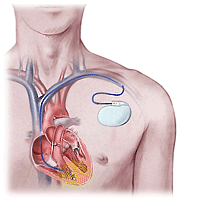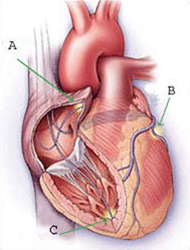Home › Treatment › At Home › AICD
Automatic Implantable Cardioverter-Defibrillator (AICD) is a device intended to convert life threatening rhythms of the heart which may cause sudden cardiac death also known as cardiac arrest, to a sinus (normal) rhythm.  Sudden cardiac death is the cause of 50% of all cardiac related deaths. When a life threatening rapid or slow rhythm is sensed by the device, an electric discharge of about 25 to 40 joules is sent through a pair of electrodes; one is sent to the pacemaker and the other to the apex of the right ventricle. Many of these devices hold a memory so the rhythm which induced the AICD may be recorded for later analysis.
Sudden cardiac death is the cause of 50% of all cardiac related deaths. When a life threatening rapid or slow rhythm is sensed by the device, an electric discharge of about 25 to 40 joules is sent through a pair of electrodes; one is sent to the pacemaker and the other to the apex of the right ventricle. Many of these devices hold a memory so the rhythm which induced the AICD may be recorded for later analysis.
Biventricular Pacing
In the course of worsening heart failure, some hearts will incur damage to the specialized heart cells that carry signals needed for proper contraction. When this causes the signals to travel out of sync, the pumping becomes less forceful and efficient. This knowledge has spurred the development of devices for “biventricular pacing.”
 How It Works
How It Works
Standard implanted pacemakers are equipped with two wires (or “leads”) that conduct pacing signals to specific regions of the heart (usually at positions A and C). The biventricular pacing devices have added a third lead (to position B) that is designed to conduct signals directly into the left ventricle. The combination of all three leads creates a synchronized pumping of the ventricles, increasing the efficiency of each beat and pumping more blood on the whole. Since only 15 to 25% of heart failure patients will have the specific conditions that would warrant implantation of a biventricular pacer, this resynchronization device will not replace most standard heart failure treatments and medications.


 Español
Español











